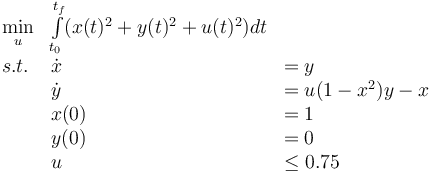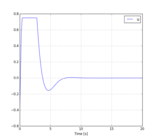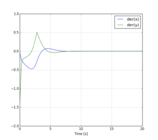Difference between revisions of "Van der Pol Oscillator"
FelixMueller (Talk | contribs) (→Optimal Control Problem) |
FelixMueller (Talk | contribs) (→Optimal Control Problem) |
||
| Line 36: | Line 36: | ||
<math> \begin{array}{lll} | <math> \begin{array}{lll} | ||
| − | \min\limits_{u} & \int\limits_{t_0}^{t_f} | + | \min\limits_{u} & \int\limits_{t_0}^{t_f}(x(t)^2+y(t)^2+u(t)^2) dt\\ |
s.t. & \dot x &= y\\ | s.t. & \dot x &= y\\ | ||
& \dot y &= u(1-x^2) y-x\\ | & \dot y &= u(1-x^2) y-x\\ | ||
Revision as of 16:44, 22 February 2016
| Van der Pol Oscillator | |
|---|---|
| State dimension: | 1 |
| Differential states: | 2 |
| Discrete control functions: | 1 |
| Interior point equalities: | 2 |
The Van der Pol Oscillator is an oscillating system with non-linear damping and self regulation. The System was first introduced by the Dutch physician Balthasar Van der Pol in 1927. The aim is to control the oscillation such that the system stays in a mean position.
Contents
Model formulation
The Van der Pol Oscillator evolves over time according to the second order differential equation:

where  is the position coordinate, which is a function of the time
is the position coordinate, which is a function of the time  , and
, and  is a scalar parameter indicating the non-linearity and the strength of the damping.
is a scalar parameter indicating the non-linearity and the strength of the damping.
For  the oscillator is being damped, whereas for
the oscillator is being damped, whereas for  energy is added to the system.
energy is added to the system.
Based on the transformation  the problem can be reformulated:
the problem can be reformulated:


The Optimal Control Problem arises by adding the objective function:

Optimal Control Problem
The Optimal Control Problem with the aim to minimize the deflection can be formulated as follows:

Parameters
These fixed values are used within the model:
![[t_0,t_f]=[0,20]](https://mintoc.de/images/math/d/4/a/d4a8409487693407b169d542957e0321.png)
Reference Solution
The following reference solution was generated using JModelica with the automatic differentiation tool CasADI and the solver IPOPT. The Optimica code used to solve the problem can be found under Van der Pol Oscillator (JModelica) The optimal value of the objective function is 3.1762.
- Reference solution plots
Source Code
Model descriptions are available in:
- JModelica code at Van der Pol Oscillator (JModelica)
- JuMP code (of a slightly modified Van der Pol oscillator problem) at Van der Pol Oscillator (Jump)
References
The Problem can be found under the following link or in the JModelica Users Guide.



 and second derivative
and second derivative  .
.